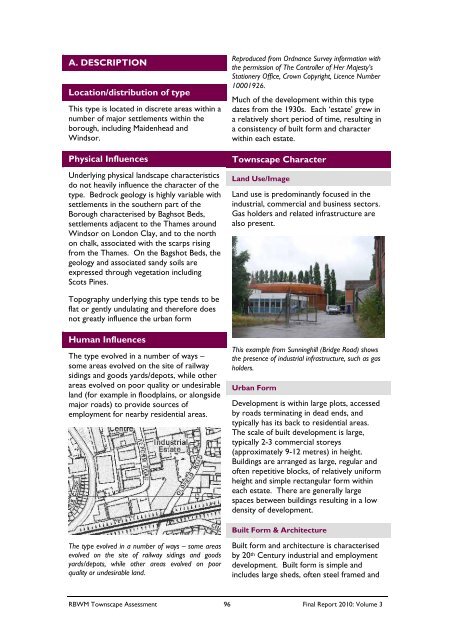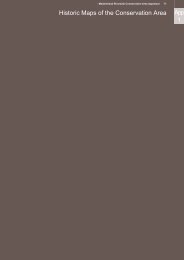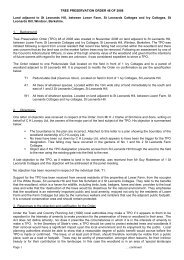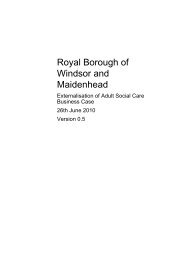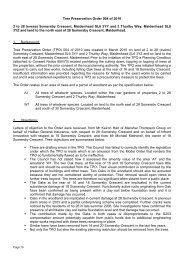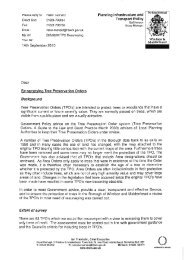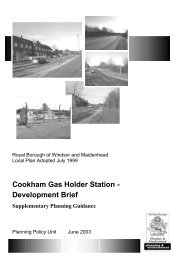5: victorian villages - The Royal Borough of Windsor and Maidenhead
5: victorian villages - The Royal Borough of Windsor and Maidenhead
5: victorian villages - The Royal Borough of Windsor and Maidenhead
Create successful ePaper yourself
Turn your PDF publications into a flip-book with our unique Google optimized e-Paper software.
A. DESCRIPTION<br />
Location/distribution <strong>of</strong> type<br />
This type is located in discrete areas within a<br />
number <strong>of</strong> major settlements within the<br />
borough, including <strong>Maidenhead</strong> <strong>and</strong><br />
<strong>Windsor</strong>.<br />
Physical Influences<br />
Underlying physical l<strong>and</strong>scape characteristics<br />
do not heavily influence the character <strong>of</strong> the<br />
type. Bedrock geology is highly variable with<br />
settlements in the southern part <strong>of</strong> the<br />
<strong>Borough</strong> characterised by Baghsot Beds,<br />
settlements adjacent to the Thames around<br />
<strong>Windsor</strong> on London Clay, <strong>and</strong> to the north<br />
on chalk, associated with the scarps rising<br />
from the Thames. On the Bagshot Beds, the<br />
geology <strong>and</strong> associated s<strong>and</strong>y soils are<br />
expressed through vegetation including<br />
Scots Pines.<br />
Reproduced from Ordnance Survey information with<br />
the permission <strong>of</strong> <strong>The</strong> Controller <strong>of</strong> Her Majesty’s<br />
Stationery Office, Crown Copyright, Licence Number<br />
10001926.<br />
Much <strong>of</strong> the development within this type<br />
dates from the 1930s. Each ‘estate’ grew in<br />
a relatively short period <strong>of</strong> time, resulting in<br />
a consistency <strong>of</strong> built form <strong>and</strong> character<br />
within each estate.<br />
Townscape Character<br />
L<strong>and</strong> Use/Image<br />
L<strong>and</strong> use is predominantly focused in the<br />
industrial, commercial <strong>and</strong> business sectors.<br />
Gas holders <strong>and</strong> related infrastructure are<br />
also present.<br />
Topography underlying this type tends to be<br />
flat or gently undulating <strong>and</strong> therefore does<br />
not greatly influence the urban form<br />
Human Influences<br />
<strong>The</strong> type evolved in a number <strong>of</strong> ways –<br />
some areas evolved on the site <strong>of</strong> railway<br />
sidings <strong>and</strong> goods yards/depots, while other<br />
areas evolved on poor quality or undesirable<br />
l<strong>and</strong> (for example in floodplains, or alongside<br />
major roads) to provide sources <strong>of</strong><br />
employment for nearby residential areas.<br />
This example from Sunninghill (Bridge Road) shows<br />
the presence <strong>of</strong> industrial infrastructure, such as gas<br />
holders.<br />
Urban Form<br />
Development is within large plots, accessed<br />
by roads terminating in dead ends, <strong>and</strong><br />
typically has its back to residential areas.<br />
<strong>The</strong> scale <strong>of</strong> built development is large,<br />
typically 2-3 commercial storeys<br />
(approximately 9-12 metres) in height.<br />
Buildings are arranged as large, regular <strong>and</strong><br />
<strong>of</strong>ten repetitive blocks, <strong>of</strong> relatively uniform<br />
height <strong>and</strong> simple rectangular form within<br />
each estate. <strong>The</strong>re are generally large<br />
spaces between buildings resulting in a low<br />
density <strong>of</strong> development.<br />
Built Form & Architecture<br />
<strong>The</strong> type evolved in a number <strong>of</strong> ways – some areas<br />
evolved on the site <strong>of</strong> railway sidings <strong>and</strong> goods<br />
yards/depots, while other areas evolved on poor<br />
quality or undesirable l<strong>and</strong>.<br />
Built form <strong>and</strong> architecture is characterised<br />
by 20 th Century industrial <strong>and</strong> employment<br />
development. Built form is simple <strong>and</strong><br />
includes large sheds, <strong>of</strong>ten steel framed <strong>and</strong><br />
RBWM Townscape Assessment 96 Final Report 2010: Volume 3


